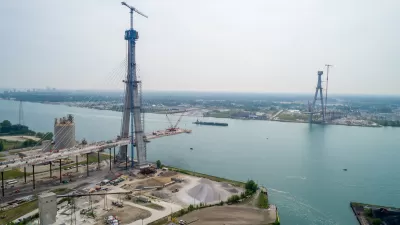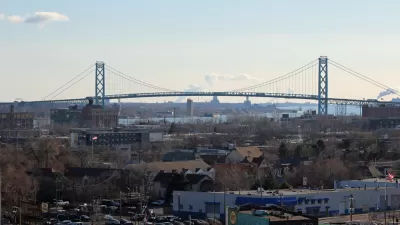A plan to build the nation's longest cable-stayed bridge has been busy clearing benchmarks this summer.

Chad Livengood reports on the expected costs of the planned Gordie Howe International Bridge that would connect Detroit to Canada in Windsor.
"The consortium of infrastructure companies that will construct the Gordie Howe International Bridge have agreed to a fixed cost of more than $2.67 billion to build what will become North America's largest cable-stayed bridge over the Detroit River," according to Livengood.
Those details were revealed in a credit-report rating published by S&P Global Ratings. Also included in the report is a construction schedule: a 74-month construction process expected to be complete in time for the bridge to open on November 30, 2024. "That construction schedule includes building the 148-acre U.S. and 131-acre Canadian ports of entry and connections to Interstate 75 in southwest Detroit," adds Livengood.
Livengood also reported in July when the Windsor-Detroit Bridge Authority selected the Bridging North America General Partnership "to design, finance, build and operate the Gordie Howe bridge for 36 years." Planetizen also picked up the news in August when Wayne County Circuit Court Chief Judge Robert Colombo Jr. cleared the way for the bridge to proceed after the rival Detroit International Bridge Company attempted to block the project in the courts.
FULL STORY: Gordie Howe bridge cost to top $2.67 billion

Trump Administration Could Effectively End Housing Voucher Program
Federal officials are eyeing major cuts to the Section 8 program that helps millions of low-income households pay rent.

Planetizen Federal Action Tracker
A weekly monitor of how Trump’s orders and actions are impacting planners and planning in America.

Ken Jennings Launches Transit Web Series
The Jeopardy champ wants you to ride public transit.

Crime Continues to Drop on Philly, San Francisco Transit Systems
SEPTA and BART both saw significant declines in violent crime in the first quarter of 2025.

How South LA Green Spaces Power Community Health and Hope
Green spaces like South L.A. Wetlands Park are helping South Los Angeles residents promote healthy lifestyles, build community, and advocate for improvements that reflect local needs in historically underserved neighborhoods.

Sacramento Plans ‘Quick-Build’ Road Safety Projects
The city wants to accelerate small-scale safety improvements that use low-cost equipment to make an impact at dangerous intersections.
Urban Design for Planners 1: Software Tools
This six-course series explores essential urban design concepts using open source software and equips planners with the tools they need to participate fully in the urban design process.
Planning for Universal Design
Learn the tools for implementing Universal Design in planning regulations.
Heyer Gruel & Associates PA
Ada County Highway District
Institute for Housing and Urban Development Studies (IHS)
City of Grandview
Harvard GSD Executive Education
Toledo-Lucas County Plan Commissions
Salt Lake City
NYU Wagner Graduate School of Public Service




























